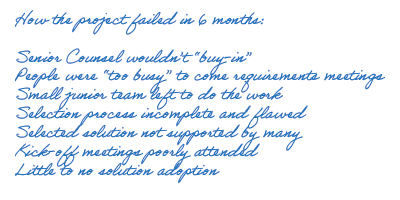
If you’re an in-house counsel, there is little doubt that you are an expert in legal matters. You have the education, experience, and battle scars to bear witness to that. You can mine that vast experience when having to come up with snap judgements and opinions by using your “gut” or intuitive instincts.
In high-knowledge, high-experience realms, it’s not necessarily a bad thing to incorporate your intuitive insights, if you understand what cognitive biases you may be bringing along with you. But, in low-knowledge, low-experience situations, relying on intuition is a high-risk proposition.
Evaluating legal technology investments, and their probability of adding value to your operations as in-house counsel, likely falls in the low-knowledge category.
It's easy to fall into the trap of thinking we are perfectly capable of making technology decisions. As leaders, we’re rewarded for sounding and acting confident with very little information. People in your organization want fast, short answers to their legal questions so they can get on with their work. They love when you deliver answers relying on your intuition, even when being deliberative might be more effective.
Being deliberate makes people think you don’t know what you’re doing and slows things down. And the dopamine hit you get from being required to urgently weigh in on matters of importance, makes it hard to kick the habit. However, your job as a leader is to know how to get the best of your resources to deliver the most value to your organization, and that includes you. Sometimes that means using different decision-making approaches.
“It is remarkable how much long-term advantage people like us have gotten by trying to be consistently not stupid, instead of trying to be very intelligent.” Charlie Munger
So, how does one slow down and incorporate deliberative decision-making and management actions? Follow the evidence. In this context we mean evidence-based management practices that are proven to drive performance rather than relying on intuition, anecdote, and myth.
Among the many effective evidence-based management practices to improve the chances of a project’s success is a prospective hindsight method called a premortem. A premortem is the hypothetical opposite of a postmortem. A postmortem in a medical setting allows health professionals and the family to learn what caused a patient’s death.
A premortem in a business environment comes at the beginning of a project rather than the end. Before you make an important decision, and your goal is to ensure you’re harnessing the intelligence of your whole team, you a set up the following scenario.
“Suppose it’s two years from now, and we made the decision to implement a technology solution for [x] purposes, and it turned out to be a disaster. Now, you have a page in front of you. Write the history of that disaster in bullet points.”
Developing the list of bullet points is completed individually with no influence or opinions expressed by the leader. Then each person is asked to read out one reason from their list at a time until all unique reasons have been compiled. Next, the list is compiled and distributed to the team in preparation for the next session, where they are asked to come prepared with suggestions for how to avoid these reasons for failure before they happen.

In the failure avoidance session, teams build a list of unique reasons for failure and can rank the most likely culprits to cause failure. Then as a group they can craft strategies for avoiding that failure. This process also sensitizes the team to spot early warning signs once the project gets underway and encourages people to raise doubts that might otherwise have gone unsaid.
Typical premortems for in-house legaltech decisions will include reasons for failure like, no in-house subject matter expertise, no time to fully vet the candidate offerings, no ability to start small or experiment, no history of successful legal technology adoptions, no IT support for new legal technology, no time for adequate training and customization of the solution, little management support or budget, etc. But each organization will have their own operational, cultural, political, and personnel related failure points.
Is a premortem a sure-fire way to avoid failures? No, mistakes can still happen. Premortems just lessen the probability that big mistakes will derail the project and enable the team to sense and respond to problems more quickly.
